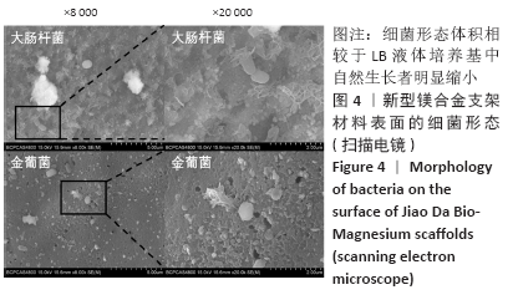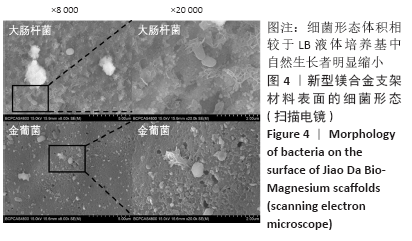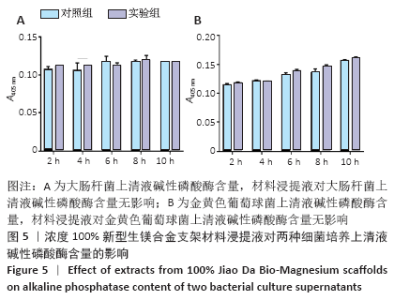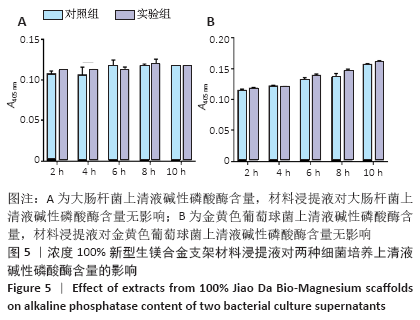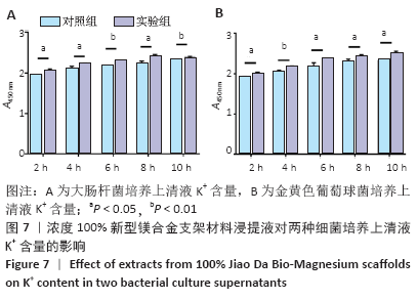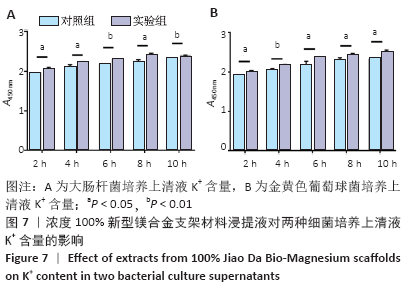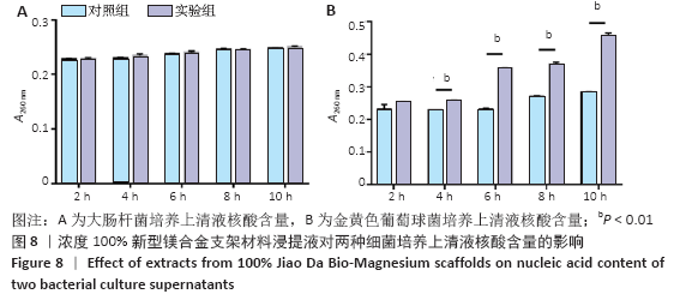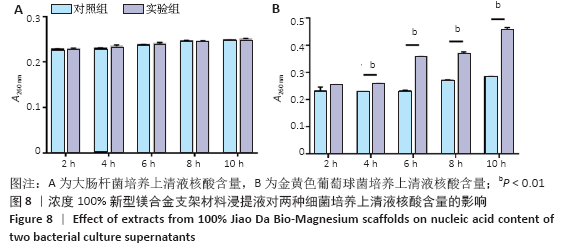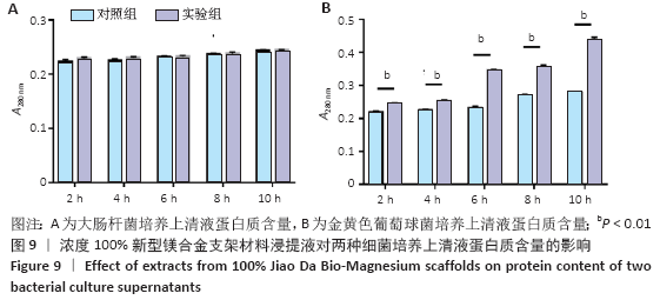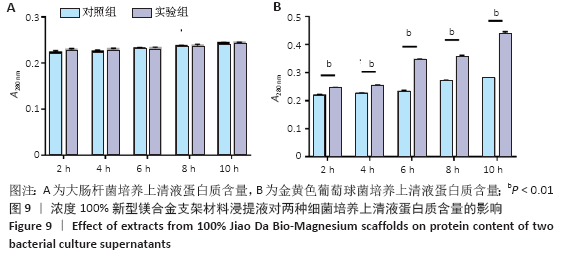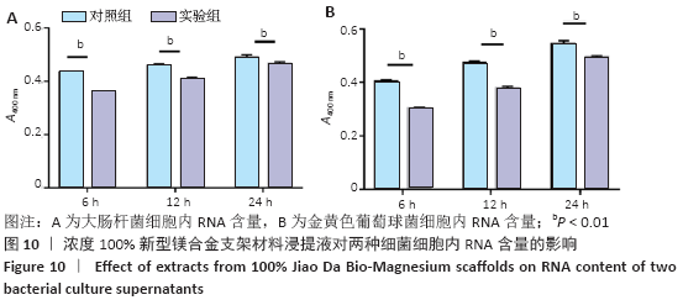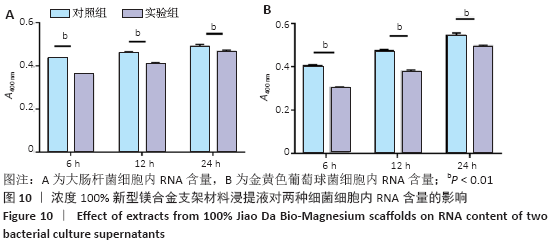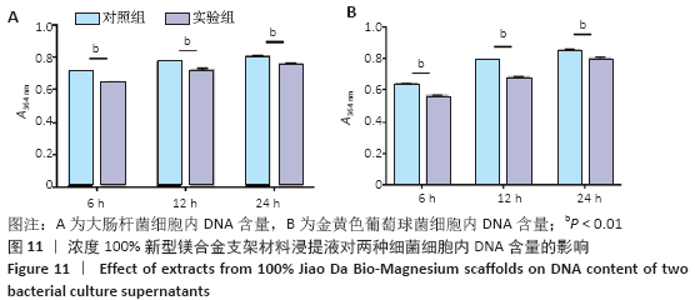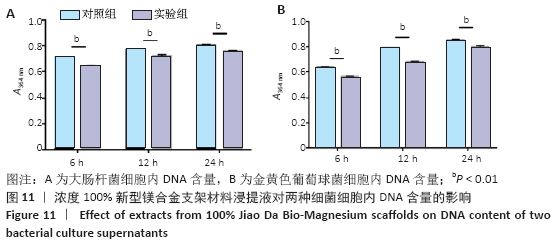Chinese Journal of Tissue Engineering Research ›› 2021, Vol. 25 ›› Issue (16): 2506-2513.doi: 10.3969/j.issn.2095-4344.3151
Previous Articles Next Articles
Antibacterial properties of Jiao Da Bio-Magnesium scaffolds in vitro
Wang Liang1, Guo Yuxing1, Wu Xun1, Huang Hua2, Yuan Guangyin2, Zhang Lei1
- 1Department of Oral and Maxillofacial Surgery, Hospital of Stomatology, Peking University, Beijing 100081, China; 2National Engineering Research Center of Light Alloys Net Forming, Shanghai Jiao Tong University, Shanghai 200240, China
-
Received:2020-03-06Revised:2020-03-11Accepted:2020-05-16Online:2021-06-08Published:2021-01-07 -
Contact:Zhang Lei, Chief physician, Department of Oral and Maxillofacial Surgery, Hospital of Stomatology, Peking University, Beijing 100081, China -
About author:Wang Liang, Master candidate, Physician, Department of Oral and Maxillofacial Surgery, Hospital of Stomatology, Peking University, Beijing 100081, China -
Supported by:the Key Research and Development Sub-Project of Ministry of Science and Technology, No. 2016YFC1102104 (to ZL); the National Natural Science Foundation of China, No. 51571143 (to YGY); the Project of Shanghai Health and Family Planning Commission, No. 201640281 (to YGY)
CLC Number:
Cite this article
Wang Liang, Guo Yuxing, Wu Xun, Huang Hua, Yuan Guangyin, Zhang Lei. Antibacterial properties of Jiao Da Bio-Magnesium scaffolds in vitro[J]. Chinese Journal of Tissue Engineering Research, 2021, 25(16): 2506-2513.
share this article
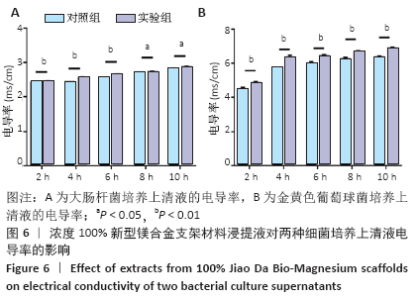
2.4 电导率检测结果 细菌在生长过程中与外界环境不断的进行物质交换,包含K+、Na+等小分子物质及蛋白质、链状核苷酸等大分子物质,这些带电物质的跨膜运动使细胞外液体环境的带电粒子数目发生变化,带电粒子总数的变化可用导电率测得。而细胞膜的完整性是有序调控这些物质交换的前提,即细胞外液体环境的导电率可在一定程度上反映细胞膜的完整性。 无论是大肠杆菌还是金黄色葡萄球菌,实验组与对照组细胞外液环境导电率均随时间延长而增大,并且不同时间点对照组导电率均低于实验组(P < 0.05,P < 0.01),见图6。结果表明,实验组细菌细胞内外环境的带电粒子分布出现变化,即材料浸提液对两种细菌细胞膜的完整性有影响。"
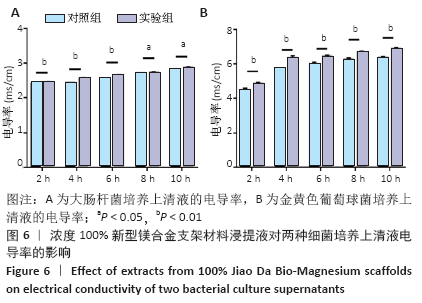

2.8 细胞内可溶性蛋白含量检测结果 蛋白质是细胞生命的物质基础,细菌内蛋白质含量的变化可间接反映细菌生命活动的活跃程度。 通过对比蛋白质Marker的染色条带分析可知大肠杆菌的可溶性蛋白质分子质量在10-170 kD之间;而金黄色葡萄球菌的可溶性蛋白质分子质量在10-300 kD之间,分布宽度大于大肠杆菌,见图12。大肠杆菌中实验组与对照组不同时间点各分子质量蛋白质分布无明显差异,表明材料浸提液对大肠杆菌菌体内蛋白质的合成无明显抑制作用;金黄色葡萄球菌中实验组相较于对照组最大分子质量的蛋白质条带变浅,且随时间延长这种差异减弱,表明材料浸提液对金黄色葡萄球菌菌体内蛋白质合成具有抑制作用,进一步推测该结果可能是材料浸提液对金黄色葡萄球菌内维持高分子质量蛋白质结构的某些化学键有破坏作用,或者直接抑制了高分子量蛋白质的合成,而且这种抑制作用随接触时间的延长逐渐变弱。 "

| [1] 成翔宇,纪斌,庞金辉.骨折的生物学内固定及内固定材料性能分析[J].中国组织工程研究, 2012,16(22):4121-4124. [2] 杨柯,任玲,张余,等.新型抗菌功能医用金属研究[J].中国材料进展,2012,31(9):20-26. [3] 曲立杰,李慕勤,刘苗,等.超声-微弧氧化医用镁合金体外降解性研究[J].稀有金属材料与工程,2014,43(S1):96-100. [4] Niu J, Yuan G, Liao Y, et al. Enhanced biocorrosion resistance and biocompatibility of degradable Mg-Nd-Zn-Zr alloy by brushite coating.Mater Sci Eng C Mater Biol Appl. 2013;33(8):4833-4841. [5] 马剑雄,高峰,柏豪豪,等.可降解生物材料在骨科内固定中的研究及应用进展[J].生物医学工程与临床,2016,20(3):323-327. [6] 孔祥东,郝永强,王磊,等.新型医用可降解镁合金(JDBM)螺钉的生物安全性研究[J].组织工程与重建外科杂志,2015,11(3):124-127. [7] 袁广银,牛佳林.可降解医用镁合金在骨修复应用中的研究进展[J].金属学报,2017,53(10):1168-1180. [8] 郭宇,娄译心,周延民,等.镁合金成骨作用及机制的研究进展[J].口腔医学研究,2016,32(5):541-544. [9] YOSHIZAWA S, BROWN A, BARCHOWSKY A, et al. Role of magnesium ions on osteogenic response in bone marrow stromal cells.Connect Tissue Res. 2014;55 Suppl 1:155-159. [10] 王湛,杨军,李建军.新型骨科植入物镁合金材料抗菌性能的体外实验研究[J].中国医科大学学报,2014,43(12):1142-1144. [11] ZHAO C, HOU P, NI J, et al. Ag-Incorporated FHA Coating on Pure Mg: Degradation and in Vitro Antibacterial Properties.ACS Appl Mater Interfaces. 2016;8(8):5093-5103. [12] Jia G, Hou Y, Chen C, et al. Precise fabrication of open porous Mg scaffolds using NaCl templates: Relationship between space holder particles, pore characteristics and mechanical behavior. Mater Design. 2018;140:106-113. [13] 奚廷斐.医疗器械生物学评价标准[M].北京:中国标准出版社, 2012. [14] 张新虎,何静,沈慧敏.苍耳提取物对番茄灰霉病菌的抑制作用及抑菌机理初探[J].草业学报,2008(3):99-104. [15] 云宝仪,周磊,谢鲲鹏,等.黄芩素抑菌活性及其机制的初步研究[J].药学学报,2012,47(12):1587-1592. [16] 李昌勤,赵琳,薛志平,等.隐丹参酮抑菌作用机制研究[J].中国药学杂志,2012,47(21):1706-1710. [17] 王倩,谢明杰.木犀草素对金黄色葡萄球菌的抑菌活性及其机制[J].微生物学报,2010,50(9):1180-1184. [18] 王海涛,王倩,谢明杰.大豆异黄酮对金黄色葡萄球菌的抑菌机制研究[J].中国农业科学,2009,42(7):2586-2591. [19] 马骏,李国庆,曹力.结核杆菌黏附不同人工关节假体材料的能力研究[J].中国组织工程研究,2012,16(47):8807-8812. [20] ROBINSON DA, GRIFFITH RW, SHECHTMAN D, et al. In vitro antibacterial properties of magnesium metal against Escherichia coli, Pseudomonas aeruginosa and Staphylococcus aureus. Acta Biomater. 2010;6(5): 1869-1877. [21] 蓝国波,张余.抗菌金属植入材料的研究进展[J].中华关节外科杂志(电子版),2012,6(6):961-966. [22] 杨小卫,李小康,郭征,等.骨科金属置入物并发感染的动物模型构建方法及效果评价[J].中国矫形外科杂志,2012,20(16): 1505-1509. [23] Shirai T, Shimizu T, Ohtani K, et al. Antibacterial iodine-supported titanium implants. Acta Biomater. 2011;7(4):1928-1933. [24] Donlan RM. Biofilms and device-associated infections. Emerg Infect Dis. 2001;7(2):277-281. [25] 任玲,杨春光,杨柯.抗菌医用金属材料的研究与发展[J].中国医疗设备,2017,32(1):1-6. [26] ARCIOLA CR, CAMPOCCIA D, GAMBERINI S, et al. Detection of slime production by means of an optimised Congo red agar plate test based on a colourimetric scale in Staphylococcus epidermidis clinical isolates genotyped for ica locus.Biomaterials.2002;23(PII S0142-9612 (02)00171-021):4233-4239. [27] DAYAGHI E, BAKHSHESHI-RAD HR, HAMZAH E, et al. Magnesium-zinc scaffold loaded with tetracycline for tissue engineering application: In vitro cell biology and antibacterial activity assessment.Mater Sci Eng C Mater Biol Appl. 2019;102:53-65. [28] JI XJ, GAO L, LIU JC, et al. Corrosion resistance and antibacterial properties of hydroxyapatite coating induced by gentamicin-loaded polymeric multilayers on magnesium alloys. Colloids Surf B Biointerfaces. 2019;179:429-436. [29] MAO L, SHEN L, CHEN J, et al. Enhanced bioactivity of Mg-Nd-Zn-Zr alloy achieved with nanoscale MgF2 surface for vascular stent application. ACS Appl Mater Interfaces. 2015;7(9):5320-5330. [30] SONG J, JIN P, LI M, et al. Antibacterial properties and biocompatibility in vivo and vitro of composite coating of pure magnesium ultrasonic micro-arc oxidation phytic acid copper loaded. J Mater Sci Mater Med. 2019;30(5):49. [31] LIU C, FU X, PAN H, et al. Biodegradable Mg-Cu alloys with enhanced osteogenesis, angiogenesis, and long-lasting antibacterial effects. Sci Rep. 2016;6:27374. [32] SIKDER P, BHADURI SB, ONG JL, et al. Silver (Ag) doped magnesium phosphate microplatelets as next-generation antibacterial orthopedic biomaterials. J Biomed Mater Res B Appl Biomater. 2020;108(3): 976-989. [33] WINDHAGEN H, RADTKE K, WEIZBAUER A, et al. Biodegradable magnesium-based screw clinically equivalent to titanium screw in hallux valgus surgery: short term results of the first prospective, randomized, controlled clinical pilot study. Biomed Eng Online. 2013;12:62. [34] LEE JW, HAN HS, HAN KJ, et al. Long-term clinical study and multiscale analysis of in vivo biodegradation mechanism of Mg alloy. Proc Natl Acad Sci U S A. 2016;113(3):716-721. [35] ZENG J, REN L, YUAN Y, et al. Short-term effect of magnesium implantation on the osteomyelitis modeled animals induced by Staphylococcus aureus. J Mater Sci Mater Med. 2013;24(10): 2405-2416. [36] LI Y, LIU G, ZHAI Z, et al. Antibacterial properties of magnesium in vitro and in an in vivo model of implant-associated methicillin-resistant Staphylococcus aureus infection. Antimicrob Agents Chemother. 2014;58(12):7586-7591. [37] Ren L, Lin X, Tan L, et al. Effect of surface coating on antibacterial behavior of magnesium based metals. Mater Lett. 2011;65(23-24): 3509-3511. [38] WU H, WU G, WANG G, et al. Systematic Study of Inherent Antibacterial Properties of Magnesium-based Biomaterials. ACS Appl Mater Interfaces. 2016;8(15):9662-9673. [39] 袁广银,章晓波,牛佳林,等.新型可降解生物医用镁合金JDBM的研究进展[J].中国有色金属学报,2011,21(10):2476-2488. [40] BJARNSHOLT T, KIRKETERP-MOLLER K, KRISTIANSEN S, et al. Silver against Pseudomonas aeruginosa biofilms. APMIS. 2007;115(8): 921-928. [41] MA R, WANG W, YANG P, et al. In vitro antibacterial activity and cytocompatibility of magnesium-incorporated poly(lactide-co-glycolic acid) scaffolds. Biomed Eng Online. 2020;19(1):12. [42] YAMAMOTO A, HIROMOTO S. Effect of inorganic salts, amino acids and proteins on the degradation of pure magnesium in vitro. Mater Sci Eng C-Biomimetic Supramol Syst. 2009;29(5):1559-1568. [43] 甄珍,奚廷斐,郑玉峰.生物可降解金属材料体外腐蚀测试体系综述(英文)[J]中国有色金属学报(英文版),2013,23(8):2283-2293. [44] HIROMOTO S, YAMAMOTO A, MARUYAMA N, et al. Influence of pH and flow on the polarisation behaviour of pure magnesium in borate buffer solutions. Corros Sci. 2008;50(12):3561-3568. [45] FENG H, WANG G, JIN W, et al. Systematic Study of Inherent Antibacterial Properties of Magnesium-based Biomaterials. ACS Appl Mater Interfaces. 2016;8(15):9662-9673. [46] He G, Wu Y, Zhang Y, et al. Addition of Zn to the ternary Mg-Ca-Sr alloys significantly improves their antibacterial properties. J Mater Chem B. 2015;3(32):6676-6689. [47] ZOU YH, WANG J, CUI LY, et al. Corrosion resistance and antibacterial activity of zinc-loaded montmorillonite coatings on biodegradable magnesium alloy AZ31. Acta Biomater. 2019;98:196-214. [48] 于潞,杨敏,李默,等.金黄色葡萄球菌与大肠埃希菌在不同环境下存活率的比较[J].中国病原生物学杂志,2016,11(2):110-115. [49] 薛东芳,邹宗尧,陈彪,等.黄连总生物碱与小檗碱对嗜水气单胞菌细胞膜损伤机制的研究[J].中国中药杂志,2015,40(9):1787-1792. |
| [1] | Che Yanjun, Hu Dan, Si Weibing, Gu Xueping, Hao Yuefeng. Bone cement interval perfusion in hyperextension position for treatment of senile osteoporotic vertebral compression fractures [J]. Chinese Journal of Tissue Engineering Research, 2022, 26(10): 1555-1561. |
| [2] | Xu Feng, Kang Hui, Wei Tanjun, Xi Jintao. Biomechanical analysis of different fixation methods of pedicle screws for thoracolumbar fracture [J]. Chinese Journal of Tissue Engineering Research, 2021, 25(9): 1313-1317. |
| [3] | Jiang Yong, Luo Yi, Ding Yongli, Zhou Yong, Min Li, Tang Fan, Zhang Wenli, Duan Hong, Tu Chongqi. Von Mises stress on the influence of pelvic stability by precise sacral resection and clinical validation [J]. Chinese Journal of Tissue Engineering Research, 2021, 25(9): 1318-1323. |
| [4] | Zhang Tongtong, Wang Zhonghua, Wen Jie, Song Yuxin, Liu Lin. Application of three-dimensional printing model in surgical resection and reconstruction of cervical tumor [J]. Chinese Journal of Tissue Engineering Research, 2021, 25(9): 1335-1339. |
| [5] | Zhang Yu, Tian Shaoqi, Zeng Guobo, Hu Chuan. Risk factors for myocardial infarction following primary total joint arthroplasty [J]. Chinese Journal of Tissue Engineering Research, 2021, 25(9): 1340-1345. |
| [6] | Wei Wei, Li Jian, Huang Linhai, Lan Mindong, Lu Xianwei, Huang Shaodong. Factors affecting fall fear in the first movement of elderly patients after total knee or hip arthroplasty [J]. Chinese Journal of Tissue Engineering Research, 2021, 25(9): 1351-1355. |
| [7] | Wang Jinjun, Deng Zengfa, Liu Kang, He Zhiyong, Yu Xinping, Liang Jianji, Li Chen, Guo Zhouyang. Hemostatic effect and safety of intravenous drip of tranexamic acid combined with topical application of cocktail containing tranexamic acid in total knee arthroplasty [J]. Chinese Journal of Tissue Engineering Research, 2021, 25(9): 1356-1361. |
| [8] | Xiao Guoqing, Liu Xuanze, Yan Yuhao, Zhong Xihong. Influencing factors of knee flexion limitation after total knee arthroplasty with posterior stabilized prostheses [J]. Chinese Journal of Tissue Engineering Research, 2021, 25(9): 1362-1367. |
| [9] | Huang Zexiao, Yang Mei, Lin Shiwei, He Heyu. Correlation between the level of serum n-3 polyunsaturated fatty acids and quadriceps weakness in the early stage after total knee arthroplasty [J]. Chinese Journal of Tissue Engineering Research, 2021, 25(9): 1375-1380. |
| [10] | Zhang Chong, Liu Zhiang, Yao Shuaihui, Gao Junsheng, Jiang Yan, Zhang Lu. Safety and effectiveness of topical application of tranexamic acid to reduce drainage of elderly femoral neck fractures after total hip arthroplasty [J]. Chinese Journal of Tissue Engineering Research, 2021, 25(9): 1381-1386. |
| [11] | Wang Haiying, Lü Bing, Li Hui, Wang Shunyi. Posterior lumbar interbody fusion for degenerative lumbar spondylolisthesis: prediction of functional prognosis of patients based on spinopelvic parameters [J]. Chinese Journal of Tissue Engineering Research, 2021, 25(9): 1393-1397. |
| [12] | Lü Zhen, Bai Jinzhu. A prospective study on the application of staged lumbar motion chain rehabilitation based on McKenzie’s technique after lumbar percutaneous transforaminal endoscopic discectomy [J]. Chinese Journal of Tissue Engineering Research, 2021, 25(9): 1398-1403. |
| [13] | Chen Xinmin, Li Wenbiao, Xiong Kaikai, Xiong Xiaoyan, Zheng Liqin, Li Musheng, Zheng Yongze, Lin Ziling. Type A3.3 femoral intertrochanteric fracture with augmented proximal femoral nail anti-rotation in the elderly: finite element analysis of the optimal amount of bone cement [J]. Chinese Journal of Tissue Engineering Research, 2021, 25(9): 1404-1409. |
| [14] | Du Xiupeng, Yang Zhaohui. Effect of degree of initial deformity of impacted femoral neck fractures under 65 years of age on femoral neck shortening [J]. Chinese Journal of Tissue Engineering Research, 2021, 25(9): 1410-1416. |
| [15] | Zhang Shangpu, Ju Xiaodong, Song Hengyi, Dong Zhi, Wang Chen, Sun Guodong. Arthroscopic suture bridge technique with suture anchor in the treatment of acromioclavicular dislocation [J]. Chinese Journal of Tissue Engineering Research, 2021, 25(9): 1417-1422. |
| Viewed | ||||||
|
Full text |
|
|||||
|
Abstract |
|
|||||








